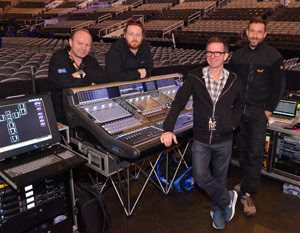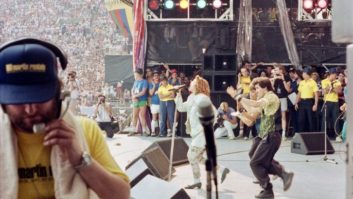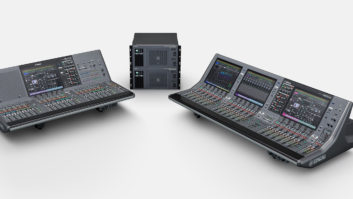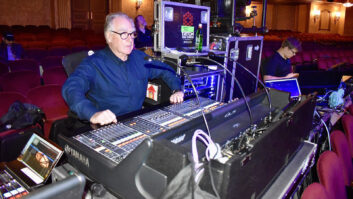
From left: Horst Hartmann and Jon Lewis (monitors), Dave Bracey (FOH), and Ulf Oeckl (system tech)
Photo: Steve Jennings
More from Bracey on the DiGiCo SD7 at FOH:
“[The “snapshot” function] is like an evolution of what started in the [DiGiCo] D5 in 2002. System engineer Sherif El Barbari and I started discussing the way snapshots should work on a live mixing console, and he started planting a seed with me, and I spent perhaps the next year fine-tuning the way one of the functions should work on the snapshot recall [on the D5]. And now it exists on the SD7. It’s evolved slowly over time, but the initial premise was suggested by Sherif and worked on by me, in indirect contact with software writers.
“It’s a system for mixing that I’ve worked out for myself in the way I update snapshots and recall snapshots. It’s so incredibly malleable to your needs, if you’re familiar with what it can do, you can structure it to really work the way you want it to work, and I quite often give people advice on this.”
Hartmann on doing all the monitor mixing earlier in the tour:
“I did both together for quite a while and then it got too big, because she’s using one ear only, so we need wedges as well, and sidefills, and we have a B-stage, so its very complicated. I ended up with more than 40 mixes, including communication mixes, and we had around 100 input channels, and I also do the RF stuff. What we decided after a while is that she needs complete attention, so that’s why we have two people now.”

Photo: Steve Jennings
Hartmann on the headset mic/in-ear setup:
“We always had problems finding a [headset] mic that would stay in place and is loud enough that you can use it in front of a P.A. Right now, the one we have is the only mic that can compete with a handheld.”
Lewis on using one or two in-ears with Pink during the show:
“Usually she’s on one ear only, so we have to keep track of the different zones around the stage, and how much that changes what she’s hearing from the P.A. and what she’s hearing from the stage itself, so it’s a lot of micro-managing little zones as she moves around.
“I’ve managed to get her to do some songs on two ears, so that is switching from a double ear mix to a single ear mix, depending on how natural it feels. It’s a very cue-heavy show for me with lots of little pushes—single words, single hits on guitars. It’s more about giving her the information for timing and pitching that she needs. I refer to it as like sign posts. In a song it might be two or three little chigs on a guitar, which might be her reference point for the next line she sings. When I joined, we had extensive discussions about what her key-ins were, and sometimes it’s not what you would imagine—it’s the second guitar, not the main guitar, or maybe something the piano is doing. It’s whatever she feels will pull her into a pitch reference. I’ve suggested a few things that might help her, and it seems to be working out well.”







